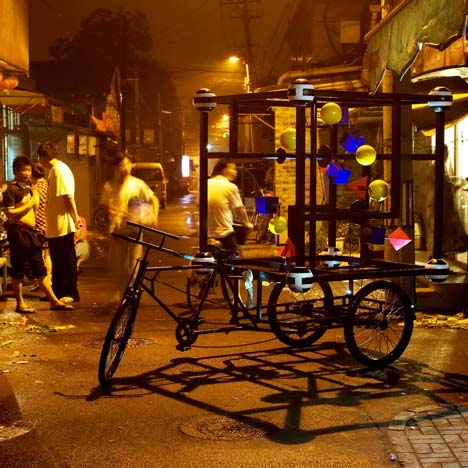Beijing Design Week 2011: French artist Niko de la Faye could be found cycling around Beijing Design Week with a rotating map of the universe on the back of his tricycle.
Top and above: photographs by Raphaël Fournier
Eight monochrome balls on the corners of the cube-shaped M2B sculpture illustrate Yin and Yang symbols to represent the Taoist map of the cosmos.
Above: photograph is by Mathias Magg
Primary coloured cubes, prisms and spheres at the centre of the sculpture are meant to symbolise the elemental particles that fill the universe. These twelve coloured shapes are attached to the pedals and spin when the cycle is moving.
Another tricycle on show during Beijing Design Week could write temporary messages on the road with water - see this project here and see all our stories about cycles here.
See more from Beijing Design Week here and see our snapshots from the festival on our Facebook page.
The following text comes from de la Faye:
M2B reflects both tradition and modernity, and combines Eastern and Western influences.
The sculpture is made of:
- A traditional Chinese three-wheel bike
- A 1.4m cubic stainless steel structure. Its design is based on the Yin~Yang symbol, with a perfect balance between shapes.
- Eight black and white balls (fig.3) are set on the corners of the cubic structure. Each ball represent a trigram from Taoist cosmology. Trigrams consist of three lines representing Yin and Yang symbols. Each one has a specific structure that determines its location in space and its particular meaning. They are often presented in an hexagonal shape. Taoists believe that the eight trigrams are a map of the cosmos.
The whole structure is a representation of the universe.
3 axels placed Inside the cube, linked together by belts and connected to the back wheel axel by another belt. When the bike is moving it animates the whole system. The three axels move simultenaously, each one at a different speed. Four shapes are attached to each axel. There are twelve stainless steel moving shapes in total, plus four stationary ones. They are basic geometrical shapes: spheres, prisms and cubes, each in a primary color. The shapes represent the elementary particles that make up our Universe.
The black geometric structure, and the colorful elements inside, recall the aesthetic of the Dutch abstract painter, Piet Mondrian.

